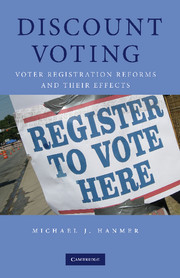Book contents
- Frontmatter
- Contents
- Acknowledgments
- Introduction
- 1 Motivation and a New Theoretical Framework
- 2 The Purposeful Adoption of Election Day Registration
- 3 Election Day Registration by Choice and by Federal Mandate
- 4 Motor Voter by Choice and by Federal Mandate
- 5 Registration and Voting in the Post-NVRA Era
- 6 Election Reform and the Composition of the Electorate
- 7 EDR on the Ground and Prospects for the Future
- APPENDICES
- References
- Index
7 - EDR on the Ground and Prospects for the Future
Published online by Cambridge University Press: 02 December 2009
- Frontmatter
- Contents
- Acknowledgments
- Introduction
- 1 Motivation and a New Theoretical Framework
- 2 The Purposeful Adoption of Election Day Registration
- 3 Election Day Registration by Choice and by Federal Mandate
- 4 Motor Voter by Choice and by Federal Mandate
- 5 Registration and Voting in the Post-NVRA Era
- 6 Election Reform and the Composition of the Electorate
- 7 EDR on the Ground and Prospects for the Future
- APPENDICES
- References
- Index
Summary
The results presented thus far demonstrate that recent registration reforms have not led to substantial increases in turnout, nor have they amplified the voices of those who are the least likely to vote beyond a blip on the volume meter. In order to address concerns that variations in the effect of election day registration (EDR) across contexts could be the result of poor implementation in the states that adopted it in response to the National Voter Registration Act (NVRA) and/or differences in the strategies political parties have used to mobilize unregistered but eligible citizens, this chapter reports on interviews I conducted with state election officials and state Democratic and Republican party leaders across the EDR states. Systematic data on EDR implementation and party responses, to the best of my knowledge, are simply not available from existing sources. Although the National Election Studies (NES) provides information regarding party mobilization efforts, asking respondents whether or not they were contacted by the political parties, the NES was designed to provide a representative sample of the nation, not individual states. Moreover, the sample size for the EDR states, which have small populations, is insufficient to allow one to draw inferences; in fact, in some study years, individuals in the less populous EDR states are not even sampled. As a result, interviews with both election officials and party leaders are used to provide insight into the implementation of EDR and how the parties' strategies are shaped by its availability.
- Type
- Chapter
- Information
- Discount VotingVoter Registration Reforms and their Effects, pp. 162 - 196Publisher: Cambridge University PressPrint publication year: 2009

